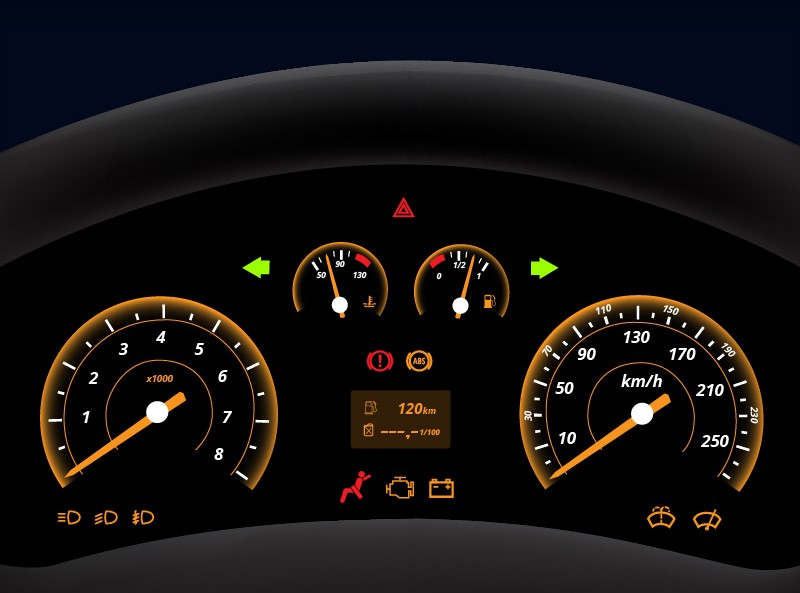Your vehicle’s battery is the heart of its electrical system, providing the power necessary to start the engine and operate various electrical components. A battery warning light serves as an important indicator that something may be amiss with your vehicle’s battery. In this article, we will explore the signs of a failing battery that may trigger the battery warning light and discuss the necessary steps to address the issue.
Understanding the Battery Warning Light: The battery warning light, often shaped like a battery symbol or the letters “ALT” or “GEN,” illuminates on the dashboard to alert you to potential battery-related problems. When the light comes on, it indicates a possible issue with the charging system, which includes the battery, alternator, voltage regulator, and associated wiring.
Signs of a Failing Battery:
- Battery Warning Light: The most obvious sign of a failing battery is the illumination of the battery warning light on your dashboard. If this light stays on after starting the engine or comes on while driving, it is a clear indication that there may be an issue with the battery or the charging system.
- Slow Engine Crank: A dying battery may struggle to provide enough power to start the engine, resulting in a slow or sluggish crank when you turn the key in the ignition. If you notice a prolonged cranking time or the engine hesitates before starting, it could be a sign of a weakening battery.
- Dimming Lights: When a battery is nearing the end of its lifespan, you may notice the headlights, interior lights, or dashboard lights becoming dimmer than usual. This occurs because the battery is unable to supply sufficient power to all the electrical components, causing them to operate at reduced intensity.
- Electrical Component Malfunctions: As the battery’s power weakens, you may experience malfunctions or erratic behavior from various electrical components. This can include issues such as power windows operating slowly, radio or infotainment system glitches, or erratic behavior from the air conditioning or heating system. These symptoms may be indicative of a failing battery or a compromised charging system.
- Battery Corrosion: Visual inspection of the battery terminals can reveal signs of corrosion. Corrosion appears as a white, powdery substance around the battery terminals and can hinder proper electrical connection. Excessive corrosion may contribute to battery inefficiency and potential failure.
Addressing Battery Issues: If you notice any signs of a failing battery or the battery warning light illuminates, it is crucial to address the issue promptly. Here’s what you can do:
- Check Battery Connections: Inspect the battery terminals and cables for any signs of corrosion or loose connections. Clean the terminals using a mixture of baking soda and water and ensure a secure and tight connection.
- Test Battery Voltage: Using a voltmeter or a battery load tester, measure the battery’s voltage. A fully charged battery should read around 12.6 volts. Anything significantly lower could indicate a weak or failing battery.
- Charge or Replace the Battery: If the battery is low on charge, you can attempt to recharge it using a battery charger. However, if the battery is old, weak, or showing signs of irreparable damage, it is advisable to replace it with a new one.
- Seek Professional Assistance: If you are unsure about the condition of your battery or are experiencing persistent battery-related issues, it is best to consult a qualified mechanic or visit a reputable auto service center. They can conduct a thorough diagnosis of the battery and the charging system to identify any underlying problems.
Preventive Battery Maintenance: To prolong the life of your vehicle’s battery and reduce the likelihood of unexpected failures, consider the following preventive maintenance tips:
- Regular Inspections: Inspect the battery regularly for signs of corrosion, damage, or leakage. If you notice any issues, have them addressed promptly.
- Keep the Battery Clean: Clean the battery terminals and cables periodically to prevent corrosion. Apply a thin coat of petroleum jelly or battery terminal protectant to minimize future corrosion.
- Avoid Excessive Electrical Drain: Minimize the use of electrical components when the engine is off, such as leaving lights or the radio on for extended periods. This helps preserve the battery’s charge.
- Check the Charging System: During routine vehicle maintenance, have the charging system inspected, including the alternator, voltage regulator, and associated wiring. A properly functioning charging system is vital for maintaining battery health.
The battery warning light is an important indicator of a failing battery or charging system issues. Recognizing the signs of a failing battery, addressing them promptly, and practicing regular battery maintenance can help prevent unexpected breakdowns and ensure reliable vehicle performance. Remember, if you are unsure about the condition of your battery or are experiencing persistent battery-related issues, it is best to consult a professional for a thorough diagnosis and appropriate solutions.











